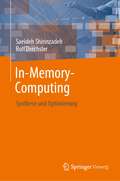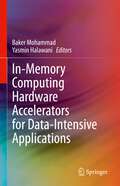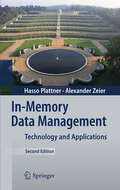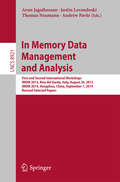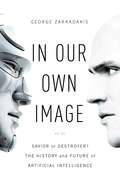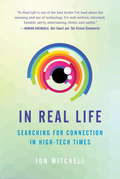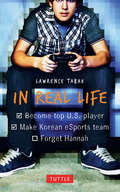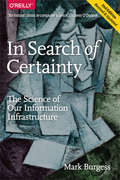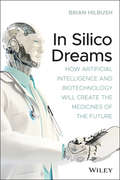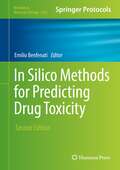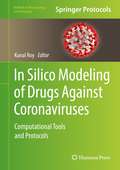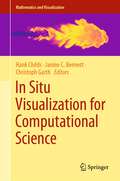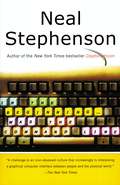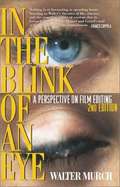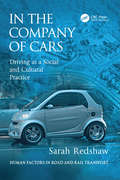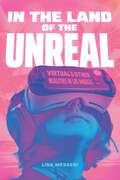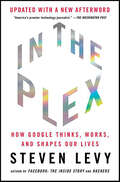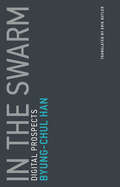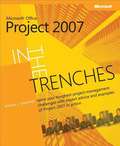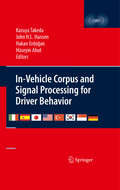- Table View
- List View
In-Memory-Computing: Synthese und Optimierung
by Saeideh Shirinzadeh Rolf DrechslerDieses Buch beschreibt einen umfassenden Ansatz für die Synthese und Optimierung von Logic-in-Memory-Computing-Hardware und -Architekturen mit memristiven Bauelementen, der eine solide Grundlage für praktische Anwendungen schafft. Die Leser werden mit einer neuen Generation von Computerarchitekturen vertraut gemacht, die potenziell schneller arbeiten können, da die Notwendigkeit der Kommunikation zwischen Prozessor und Speicher überwunden wird. Die Diskussion umfasst verschiedene Synthesemethoden und Optimierungsalgorithmen, die auf Implementierungskostenmetriken wie Latenzzeit und Flächen abzielen, sowie das Problem der Zuverlässigkeit, das durch die kurze Lebensdauer des Speichers verursacht wird. Präsentiert einen umfassenden Synthesefluss für das aufkommende Feld des Logic-in-Memory-Computings; Beschreibt die automatische Kompilierung von programmierbaren Logik-in-Memory-Computerarchitekturen; Enthält mehrere effektive Optimierungsalgorithmen, die auch auf die klassische Logiksynthese anwendbar sind; Untersucht den unausgewogenen Schreibverkehr in Logic-in-Memory-Architekturen und beschreibt Ansätze zum Verschleißausgleich, um diesen zu verringern.
In-Memory Computing Hardware Accelerators for Data-Intensive Applications
by Baker Mohammad Yasmin HalawaniThis book describes the state-of-the-art of technology and research on In-Memory Computing Hardware Accelerators for Data-Intensive Applications. The authors discuss how processing-centric computing has become insufficient to meet target requirements and how Memory-centric computing may be better suited for the needs of current applications. This reveals for readers how current and emerging memory technologies are causing a shift in the computing paradigm. The authors do deep-dive discussions on volatile and non-volatile memory technologies, covering their basic memory cell structures, operations, different computational memory designs and the challenges associated with them. Specific case studies and potential applications are provided along with their current status and commercial availability in the market.
In-Memory Data Management: Technology and Applications
by Hasso Plattner Alexander ZeierIn the last fifty years the world has been completely transformed through the use of IT. We have now reached a new inflection point. This book presents, for the first time, how in-memory data management is changing the way businesses are run. Today, enterprise data is split into separate databases for performance reasons. Multi-core CPUs, large main memories, cloud computing and powerful mobile devices are serving as the foundation for the transition of enterprises away from this restrictive model. This book provides the technical foundation for processing combined transactional and analytical operations in the same database. In the year since we published the first edition of this book, the performance gains enabled by the use of in-memory technology in enterprise applications has truly marked an inflection point in the market. The new content in this second edition focuses on the development of these in-memory enterprise applications, showing how they leverage the capabilities of in-memory technology. The book is intended for university students, IT-professionals and IT-managers, but also for senior management who wish to create new business processes.
In Memory Data Management and Analysis
by Arun Jagatheesan Justin Levandoski Thomas Neumann Andrew PavloThis book constitutes the thoroughly refereed post conference proceedings of the First and Second International Workshops on In Memory Data Management and Analysis held in Riva del Garda, Italy, August 2013 and Hangzhou, China, in September 2014. The 11 revised full papers were carefully reviewed and selected from 18 submissions and cover topics from main-memory graph analytics platforms to main-memory OLTP applications.
In Our Own Image: Savior or Destroyer? The History and Future of Artificial Intelligence
by George ZarkadakisA timely and important book that explores the history and future, as well as the societal and ethical implications, of Artificial Intelligence as we approach the cusp of a fourth industrial revolution Zarkadakis explores one of humankind's oldest love-hate relationships—our ties with artificial intelligence, or AI. He traces AI's origins in ancient myth, through literary classics like Frankenstein, to today's sci-fi blockbusters, arguing that a fascination with AI is hardwired into the human psyche. He explains AI's history, technology, and potential; its manifestations in intelligent machines; its connections to neurology and consciousness, as well as—perhaps most tellingly—what AI reveals about us as human beings. In Our Own Image argues that we are on the brink of a fourth industrial revolution—poised to enter the age of Artificial Intelligence as science fiction becomes science fact. Ultimately, Zarkadakis observes, the fate of AI has profound implications for the future of science and humanity itself.
In Real Life
by Jon MitchellTechnology helps us with our hardest work. It can also offer us endless distractions. Can technology enable us, as individuals and communities, to do our greatest possible work, the hard work of being a good person?Jon Mitchell sets out to identify and explore the ways in which we can develop a more thoughtful relationship with technology. Rather than using technology as a medium for connecting with the world, he recommends we rethink our relationship with technology, using it as a resource that allows us to have a more intimate and personal relationship with the world around us, nature, and our loved ones. Mitchell offers concrete practices for the way we use technology in our daily lives.With an accessible and conversational, easy-to-read style, Mitchell uses his years of experience as both a tech journalist and a mindfulness practitioner, to propose a rethinking of both the design of technology and its use.
In Real Life: Searching for Connection in High-Tech Times
by Jon MitchellTechnology can help us with some of our most difficult work. It can also offer us endless distractions. Can technology help us, as individuals and communities, in our most important task, that of being a good person?Jon Mitchell sets out to identify and explore the ways in which we can develop a more thoughtful relationship with technology. Rather than only using our technological devices as a medium for connecting with the world, he recommends we rethink our relationship with technology, and see it as a resource that allows us to have a more intimate and personal relationship with ourselves and the world around us. Mitchell offers concrete practices for streamlining and improving the way we use technology in our daily lives.Writing in a relatable, conversational, easy-to-read style, Mitchell draws on his years of experience as a tech journalist and mindfulness practitioner to propose a rethinking of both the design of technology and its use.
In Real Life
by Lawrence TabakFifteen-year-old math prodigy Seth Gordon knows exactly what he wants to do with his life-play video games. Every spare minute is devoted to honing his skills at Starfare, the world's most popular computer game. His goal: South Korea, where the top pros are rich and famous. But the best players train all day, while Seth has school and a job and divorced parents who agree on only one thing: "Get off that damn computer." Plus there's a new distraction named Hannah, an aspiring photographer who actually seems to understand his obsession.While Seth mopes about his tournament results and mixed signals from Hannah, Team Anaconda, one of the leading Korean pro squads, sees something special. Before he knows it, it's goodbye Kansas, goodbye Hannah, and hello to the strange new world of Korea. But the reality is more complicated than the fantasy, as he faces cultural shock, disgruntled teammates, and giant pots of sour-smelling kimchi.What happens next surprises Seth. Slowly, he comes to make new friends, and discovers what might be a breakthrough, mathematical solution to the challenges of Starcraft. Delving deeper into the formulas takes him in an unexpected direction, one that might just give him a new focus-and reunite him with Hannah.
In Real Life
by Lawrence TabakFifteen-year-old math prodigy Seth Gordon knows exactly what he wants to do with his life-play video games. Every spare minute is devoted to honing his skills at Starfare, the world's most popular computer game. His goal: South Korea, where the top pros are rich and famous. But the best players train all day, while Seth has school and a job and divorced parents who agree on only one thing: "Get off that damn computer. " Plus there's a new distraction named Hannah, an aspiring photographer who actually seems to understand his obsession. While Seth mopes about his tournament results and mixed signals from Hannah, Team Anaconda, one of the leading Korean pro squads, sees something special. Before he knows it, it's goodbye Kansas, goodbye Hannah, and hello to the strange new world of Korea. But the reality is more complicated than the fantasy, as he faces cultural shock, disgruntled teammates, and giant pots of sour-smelling kimchi. What happens next surprises Seth. Slowly, he comes to make new friends, and discovers what might be a breakthrough, mathematical solution to the challenges of Starcraft. Delving deeper into the formulas takes him in an unexpected direction, one that might just give him a new focus-and reunite him with Hannah.
In Real Life
by Lawrence TabakFifteen-year-old math prodigy Seth Gordon knows exactly what he wants to do with his life-play video games. Every spare minute is devoted to honing his skills at Starfare, the world's most popular computer game. His goal: South Korea, where the top pros are rich and famous. But the best players train all day, while Seth has school and a job and divorced parents who agree on only one thing: "Get off that damn computer. " Plus there's a new distraction named Hannah, an aspiring photographer who actually seems to understand his obsession. While Seth mopes about his tournament results and mixed signals from Hannah, Team Anaconda, one of the leading Korean pro squads, sees something special. Before he knows it, it's goodbye Kansas, goodbye Hannah, and hello to the strange new world of Korea. But the reality is more complicated than the fantasy, as he faces cultural shock, disgruntled teammates, and giant pots of sour-smelling kimchi. What happens next surprises Seth. Slowly, he comes to make new friends, and discovers what might be a breakthrough, mathematical solution to the challenges of Starcraft. Delving deeper into the formulas takes him in an unexpected direction, one that might just give him a new focus-and reunite him with Hannah.
In Real Life
by Lawrence TabakFifteen-year-old math prodigy Seth Gordon knows exactly what he wants to do with his life-play video games. Every spare minute is devoted to honing his skills at Starfare, the world's most popular computer game. His goal: South Korea, where the top pros are rich and famous. But the best players train all day, while Seth has school and a job and divorced parents who agree on only one thing: "Get off that damn computer." Plus there's a new distraction named Hannah, an aspiring photographer who actually seems to understand his obsession.While Seth mopes about his tournament results and mixed signals from Hannah, Team Anaconda, one of the leading Korean pro squads, sees something special. Before he knows it, it's goodbye Kansas, goodbye Hannah, and hello to the strange new world of Korea. But the reality is more complicated than the fantasy, as he faces cultural shock, disgruntled teammates, and giant pots of sour-smelling kimchi.What happens next surprises Seth. Slowly, he comes to make new friends, and discovers what might be a breakthrough, mathematical solution to the challenges of Starcraft. Delving deeper into the formulas takes him in an unexpected direction, one that might just give him a new focus-and reunite him with Hannah.
In Search of Certainty
by Mark BurgessQuite soon, the world's information infrastructure is going to reach a level of scale and complexity that will force scientists and engineers to approach it in an entirely new way. The familiar notions of command and control are being thwarted by realities of a faster, denser world of communication where choice, variety, and indeterminism rule. The myth of the machine that does exactly what we tell it has come to an end.What makes us think we can rely on all this technology? What keeps it together today, and how might it work tomorrow? Will we know how to build the next generation--or will we be lulled into a stupor of dependence brought about by its conveniences?In this book, Mark Burgess focuses on the impact of computers and information on our modern infrastructure by taking you from the roots of science to the principles behind system operation and design. To shape the future of technology, we need to understand how it works--or else what we don't understand will end up shaping us.This book explores this subject in three parts:Part I, Stability: describes the fundamentals of predictability, and why we have to give up the idea of control in its classical meaningPart II, Certainty: describes the science of what we can know, when we don't control everything, and how we make the best of life with only imperfect informationPart III, Promises: explains how the concepts of stability and certainty may be combined to approach information infrastructure as a new kind of virtual material, restoring a continuity to human-computer systems so that society can rely on them.
In Silico Dreams: How Artificial Intelligence and Biotechnology Will Create the Medicines of the Future
by Brian S. HilbushLearn how AI and data science are upending the worlds of biology and medicine In Silico Dreams: How Artificial Intelligence and Biotechnology Will Create the Medicines of the Future delivers an illuminating and fresh perspective on the convergence of two powerful technologies: AI and biotech. Accomplished genomics expert, executive, and author Brian Hilbush offers readers a brilliant exploration of the most current work of pioneering tech giants and biotechnology startups who have already started disrupting healthcare. The book provides an in-depth understanding of the sources of innovation that are driving the shift in the pharmaceutical industry away from serendipitous therapeutic discovery and toward engineered medicines and curative therapies. In this fascinating book, you'll discover: An overview of the rise of data science methods and the paradigm shift in biology that led to the in silico revolution An outline of the fundamental breakthroughs in AI and deep learning and their applications across medicine A compelling argument for the notion that AI and biotechnology tools will rapidly accelerate the development of therapeutics A summary of innovative breakthroughs in biotechnology with a focus on gene editing and cell reprogramming technologies for therapeutic development A guide to the startup landscape in AI in medicine, revealing where investments are poised to shape the innovation base for the pharmaceutical industry Perfect for anyone with an interest in scientific topics and technology, In Silico Dreams also belongs on the bookshelves of decision-makers in a wide range of industries, including healthcare, technology, venture capital, and government.
In Silico Methods for Predicting Drug Toxicity (Methods in Molecular Biology #2425)
by Emilio BenfenatiThis fully updated book explores all-new and revised protocols involving the use of in silico models, particularly with regard to pharmaceuticals. Divided into five sections, the volume covers the modeling of pharmaceuticals in the body, toxicity data for modeling purposes, in silico models for multiple endpoints, a number of platforms for evaluating pharmaceuticals, as well as an exploration of challenges, both scientific and sociological. Written for the highly successful Methods in Molecular Biology series, chapters include the kind of detail and implementation advice necessary for successful results. Authoritative and comprehensive, In Silico Methods for Predicting Drug Toxicity, Second Edition aims to guide the reader through the correct procedures needed to harness in silico models, a field which now touches a wide variety of research specialties.
In Silico Modeling of Drugs Against Coronaviruses: Computational Tools and Protocols (Methods in Pharmacology and Toxicology)
by Kunal RoyThis essential volume explores a variety of tools and protocols of structure-based (homology modeling, molecular docking, molecular dynamics, protein-protein interaction network) and ligand-based (pharmacophore mapping, quantitative structure-activity relationships or QSARs) drug design for ranking and prioritization of candidate molecules in search of effective treatment strategy against coronaviruses. Beginning with an introductory section that discusses coronavirus interactions with humanity and COVID-19 in particular, the book then continues with sections on tools and methodologies, literature reports and case studies, as well as online tools and databases that can be used for computational anti-coronavirus drug research. Written for the Methods in Pharmacology and Toxicology series, chapters include the kind of practical detail and implementation advice that ensures high quality results in the lab. Comprehensive and timely, In Silico Modeling of Drugs Against Coronaviruses: Computational Tools and Protocols is an ideal reference for researchers working on the development of novel anti-coronavirus drugs for SARS-CoV-2 and for coronaviruses that will likely appear in the future.
In Situ Visualization for Computational Science (Mathematics and Visualization)
by Hank Childs Janine C. Bennett Christoph GarthThis book provides an overview of the emerging field of in situ visualization, i.e. visualizing simulation data as it is generated. In situ visualization is a processing paradigm in response to recent trends in the development of high-performance computers. It has great promise in its ability to access increased temporal resolution and leverage extensive computational power. However, the paradigm also is widely viewed as limiting when it comes to exploration-oriented use cases. Furthermore, it will require visualization systems to become increasingly complex and constrained in usage. As research efforts on in situ visualization are growing, the state of the art and best practices are rapidly maturing.Specifically, this book contains chapters that reflect state-of-the-art research results and best practices in the area of in situ visualization. Our target audience are researchers and practitioners from the areas of mathematics computational science, high-performance computing, and computer science that work on or with in situ techniques, or desire to do so in future.
In the Beginning...Was the Command Line
by Neal StephensonThis is "the Word" -- one man's word, certainly -- about the art (and artifice) of the state of our computer-centric existence. And considering that the "one man" is Neal Stephenson, "the hacker Hemingway" (Newsweek) -- acclaimed novelist, pragmatist, seer, nerd-friendly philosopher, and nationally bestselling author of groundbreaking literary works (Snow Crash, Cryptonomicon, etc., etc.) -- the word is well worth hearing. Mostly well-reasoned examination and partial rant, Stephenson's In the Beginning... was the Command Line is a thoughtful, irreverent, hilarious treatise on the cyber-culture past and present; on operating system tyrannies and downloaded popular revolutions; on the Internet, Disney World, Big Bangs, not to mention the meaning of life itself.
In the Blink of an Eye: A Perspective on Film Editing Second Edition
by Walter MurchIn the Blink of an Eye is celebrated film editor Walter Murch's vivid, multifaceted, thought -- provoking essay on film editing. Starting with what might be the most basic editing question -- Why do cuts work? -- Murch treats the reader to a wonderful ride through the aesthetics and practical concerns of cutting film. Along the way, he offers his unique insights on such subjects as continuity and discontinuity in editing, dreaming, and reality; criteria for a good cut; the blink of the eye as an emotional cue; digital editing; and much more. In this second edition, Murch reconsiders and completely revises his popular first edition's lengthy meditation on digital editing (which accounts for a third of the book's pages) in light of the technological changes that have taken place in the six years since its publication.
In the Company of Cars: Driving as a Social and Cultural Practice (Human Factors in Road and Rail Transport)
by Sarah RedshawIt has long been accepted that the social and cultural meanings of the car far exceed the practical need for mobility. This book marks the first attempt to contribute to road safety, considering, in depth, these meanings and the cultures of driving that are shaped by them. In the Company of Cars examines the perspectives that young people have on cars, and explores the broader social and cultural meanings of the car, the potential it is supposed to fulfil, and the anticipated benefits it offers to young drivers. From focus-group research conducted in Australia, the book takes up the views of young people on a range of topics, from media to car use to gender performance. The author looks at the ways in which driving has been defined by articulations of the car that emphasize valued features of the car-driver, such as gender, youthfulness, status, age, power, raciness, sexiness, ruggedness and competitiveness. The book takes a global perspective on mobility, considering the impact of cars and road safety policy on quality of life, and the value and significance of other modes of travel, in a range of countries.
In the Land of the Unreal: Virtual and Other Realities in Los Angeles
by Lisa MesseriIn the mid-2010s, a passionate community of Los Angeles-based storytellers, media artists, and tech innovators formed around virtual reality (VR), believing that it could remedy society’s ills. Lisa Messeri offers an ethnographic exploration of this community, which conceptualized VR as an “empathy machine” that could provide glimpses into diverse social realities. She outlines how, in the aftermath of #MeToo, the backlash against Silicon Valley, and the turmoil of the Trump administration, it was imagined that VR—if led by women and other marginalized voices—could bring about a better world. Messeri delves into the fantasies that allowed this vision to flourish, exposing the paradox of attempting to use a singular VR experience to mend a fractured reality full of multiple, conflicting social truths. She theorizes this dynamic as unreal, noting how dreams of empathy collide with reality’s irreducibility to a “common” good. With In the Land of the Unreal, Messeri navigates the intersection of place, technology, and social change to show that technology alone cannot upend systemic forces attached to gender and race.
In the Plex: How Google Thinks, Works, and Shapes Our Lives
by Steven Levy&“The most interesting book ever written about Google&” (The Washington Post) delivers the inside story behind the most successful and admired technology company of our time, now updated with a new Afterword.Google is arguably the most important company in the world today, with such pervasive influence that its name is a verb. The company founded by two Stanford graduate students—Larry Page and Sergey Brin—has become a tech giant known the world over. Since starting with its search engine, Google has moved into mobile phones, computer operating systems, power utilities, self-driving cars, all while remaining the most powerful company in the advertising business.Granted unprecedented access to the company, Levy disclosed that the key to Google&’s success in all these businesses lay in its engineering mindset and adoption of certain internet values such as speed, openness, experimentation, and risk-taking. Levy discloses details behind Google&’s relationship with China, including how Brin disagreed with his colleagues on the China strategy—and why its social networking initiative failed; the first time Google tried chasing a successful competitor. He examines Google&’s rocky relationship with government regulators, particularly in the EU, and how it has responded when employees left the company for smaller, nimbler start-ups.In the Plex is the &“most authoritative…and in many ways the most entertaining&” (James Gleick, The New York Book Review) account of Google to date and offers &“an instructive primer on how the minds behind the world&’s most influential internet company function&” (Richard Waters, The Wall Street Journal).
In the Swarm: Digital Prospects (Untimely Meditations #3)
by Byung-Chul HanA prominent German thinker argues that—contrary to “Twitter Revolution” cheerleading—digital communication is destroying political discourse and political action. The shitstorm represents an authentic phenomenon of digital communication.—from In the SwarmDigital communication and social media have taken over our lives. In this contrarian reflection on digitized life, Byung-Chul Han counters the cheerleaders for Twitter revolutions and Facebook activism by arguing that digital communication is in fact responsible for the disintegration of community and public space and is slowly eroding any possibility for real political action and meaningful political discourse. In the predigital, analog era, by the time an angry letter to the editor had been composed, mailed, and received, the immediate agitation had passed. Today, digital communication enables instantaneous, impulsive reaction, meant to express and stir up outrage on the spot. “The shitstorm,” writes Han, ”represents an authentic phenomenon of digital communication. ”Meanwhile, the public, the senders and receivers of these communications have become a digital swarm—not a mass, or a crowd, or Negri and Hardt's antiquated notion of a “multitude,” but a set of isolated individuals incapable of forming a “we,” incapable of calling dominant power relations into question, incapable of formulating a future because of an obsession with the present. The digital swarm is a fragmented entity that can focus on individual persons only in order to make them an object of scandal. Han, one of the most widely read philosophers in Europe today, describes a society in which information has overrun thought, in which the same algorithms are employed by Facebook, the stock market, and the intelligence services. Democracy is under threat because digital communication has made freedom and control indistinguishable. Big Brother has been succeeded by Big Data.
In the Trenches with Microsoft® Office Project 2007
by Elaine MarmelMarmel is an author and president of a technical writing and software training firm, and she has written this guide to Microsoft Office Project 2007 for users who need develop the tools and techniques for all types of project management scenarios. The author combines expert advice and examples to show how Project 2007 can be used to define and set project goals, determine how dependencies and constraints will affect the project, set budgets, organize information files, communicate with teams, track progress and deal with management objectives. Problem solving approaches are also discussed such as getting back on schedule and managing cross-project conflicts. Annotation c2009 Book News, Inc. , Portland, OR (booknews. com)
In the Trenches with Microsoft® Office Project 2007
by Elaine J. MarmelLed by a well-known Project expert, you'll learn how to apply the right tools and techniques to the most common project-management scenarios you'll encounter. Most important, you'll see the effects of different approaches in action--so you can make the best decisions for your project. Orchestrate great results by learning the most effective ways to: Identify project scope and goals Evaluate project costs Drive a project plan and schedule Organize and deploy resources Monitor and communicate status Manage cuts in budget and resources Get management buy-in on essential changes Resolve cross-project conflicts Get a wayward project back on track Work out the kinks--solving real problems, in real time
In-Vehicle Corpus and Signal Processing for Driver Behavior
by Kazuya Takeda Hakan Erdogan John Hansen Huseyin AbutIn-Vehicle Corpus and Signal Processing for Driver Behavior is comprised of expanded papers from the third biennial DSPinCARS held in Istanbul in June 2007. The goal is to bring together scholars working on the latest techniques, standards, and emerging deployment on this central field of living at the age of wireless communications, smart vehicles, and human-machine-assisted safer and comfortable driving. Topics covered in this book include: improved vehicle safety; safe driver assistance systems; smart vehicles; wireless LAN-based vehicular location information processing; EEG emotion recognition systems; and new methods for predicting driving actions using driving signals. In-Vehicle Corpus and Signal Processing for Driver Behavior is appropriate for researchers, engineers, and professionals working in signal processing technologies, next generation vehicle design, and networks for mobile platforms.
